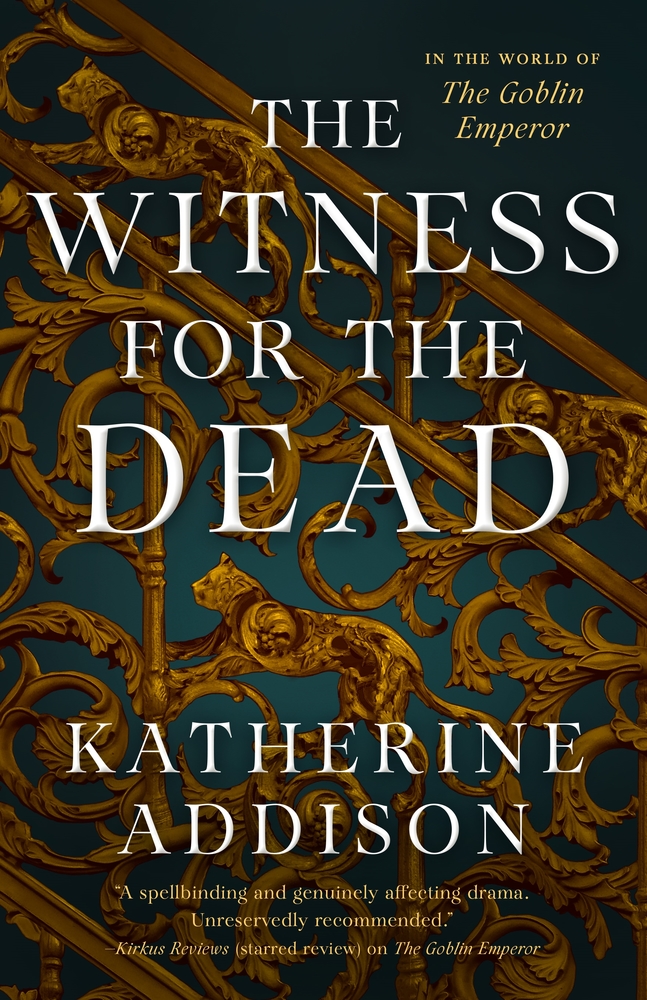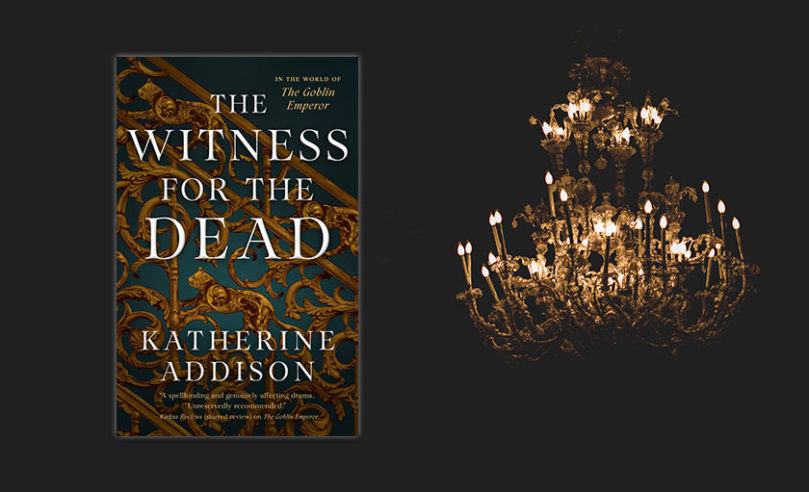 Katherine Addison returns to the glittering world she created for her beloved novel, The Goblin Emperor, in this stand-alone sequel.
Katherine Addison returns to the glittering world she created for her beloved novel, The Goblin Emperor, in this stand-alone sequel.
When the young half-goblin emperor Maia sought to learn who had set the bombs that killed his father and half-brothers, he turned to an obscure resident of his father’s Court, a Prelate of Ulis and a Witness for the Dead. Thara Celehar found the truth, though it did him no good to discover it. He lost his place as a retainer of his cousin the former Empress, and made far too many enemies among the many factions vying for power in the new Court. The favor of the Emperor is a dangerous coin.
Now Celehar lives in the city of Amalo, far from the Court though not exactly in exile. He has not escaped from politics, but his position gives him the ability to serve the common people of the city, which is his preference. He lives modestly, but his decency and fundamental honesty will not permit him to live quietly. As a Witness for the Dead, he can, sometimes, speak to the recently dead: see the last thing they saw, know the last thought they had, experience the last thing they felt. It is his duty use that ability to resolve disputes, to ascertain the intent of the dead, to find the killers of the murdered.
Now Celehar’s skills lead him out of the quiet and into a morass of treachery, murder, and injustice. No matter his own background with the imperial house, Celehar will stand with the commoners, and possibly find a light in the darkness.
Katherine Addison has created a fantastic world for these books—wide and deep and true.
Please enjoy this free excerpt of The Witness for the Dead by Katherine Addison, on sale 06/22/21.
In the morning, it was back to the Prince Zhaicava Building and the post and the papers and the wait for petitioners. No one came, and I used the time to write down everything I had learned about the dead woman.
Then, with an hour before noon and no petitioners in sight, I went down the hall to one of the other oddities housed in the Prince Zhaicava Building, the cartographers for the Amalo Municipal Tramline Authority, the clerks and mapmakers in charge of knowing exactly where the tramlines ran and of giving exact and accurate directions to the repair crews. Maps, some complete, some half drawn, some still uninked sketches, covered the walls, and there were filing cabinets full of written directions on how to get to every major landmark in Amalo from the Prince Zhaicava Building. I had overheard an argument one day about changing the starting point to the Amal’theileian, as being “more suitable,” but Dachensol Orzhimar, the master mapmaker of the Amalo Municipal Tramline Authority, said sharply, “All that would accomplish is that we’d have to add directions from here to the Amal’theileian to the start of every script.” And there the matter rested.
The mapmakers were an intense group of young elven men, passionately in love with their work. The clerks were mostly middle-aged elven ladies, efficient and serious and very proud of their abilities. They were also proud of their well-earned reputation for knowing everything that happened in Amalo, since everyone involved in the city or principate bureaucracies (insofar as the two could be separated) came to them when they needed directions to anywhere. It was amazing, Min Talenin had told me, how often the bureaucrats of the court ended up out in the city, inspecting and interviewing and participating in ceremonies.
Min Talenin and Merrem Bechevaran, the elven clerks who had the office to themselves this morning, were pleased to see me. Although I did not gossip, I did ask for their help if I had a case that warranted it. I had asked them about Mer Urmenezh’s sister, and now I showed them the drawing of Arveneän Shelsin.
Min Talenin said, eyes widening, “That’s the mid-soprano from the Vermilion Opera.”
Min Talenin was a good middle-aged bourgeoise elven lady, the daughter of a clockmaker, thrifty and responsible. The only luxury she allowed herself was the opera. If she and Athris in the Zheimela agreed about the lady’s identity, it seemed most probable that they were correct.
“Are you sure?” I said, but I knew she was before she said, “Absolutely sure. What happened to her?”
“She was thrown in the canal three nights ago,” I said.
“Oh no,” said Min Talenin. I realized that I could perhaps have phrased it more tactfully.
“Who would want to do such an awful thing?” said Merrem Bechevaran, who was younger than Min Talenin and a widow.
“That’s what I’m trying to find out,” I said. “I was hoping you could help me. I need directions to the Vermilion Opera.”
“Oh, that’s easy!” said Min Talenin, brightening. She dug in one of the filing cabinets beside her desk.
Merrem Bechevaran went to the wall and began sorting among the maps. She returned with a map leaf at the same time Min Talenin emerged with a beautifully written sheet of directions.
Merrem Bechevaran spread the map out on her desk and Min Talenin said, pausing occasionally to let me scribble notes in my notebook, “So. Starting from here, you take the Mountain Road northeast until it intersects General Baizhahar Boulevard. It will be a sharp turn backwards, for you want to follow the boulevard northwest. You follow General Baizhahar until you come to the Plaza of the Armistice, where seven streets meet. You’ll take Indigo Street, which runs straight north. In one block, it crosses Vermilion Street, and the opera is on the northeast corner.”
Merrem Bechevaran came back from another filing cabinet with a drawing of the Vermilion Opera. It was a massive brick building that clearly would be impossible to miss or mistake.
“Thank you,” I said.
“Come and tell us if we are inaccurate,” said Min Talenin.
“Of course,” I said, made my bows, and departed.
After lunch at an inexpensive Barizheise zho’an, I followed Min Talenin’s directions. As always, they were as clear as you could ask directions to be, and I found the Vermilion Opera with no difficulty.
The Opera was an enormous building, four or five storeys tall and covering an entire block. The great arches of the entrance seemed like gaping mouths waiting to swallow me whole.
I told myself sternly not to be ridiculous.
I had never been to the Vermilion Opera before—the ticket prices, even for the pit, were far beyond my meager budget. I was unprepared for the rich vermilion walls of the lobby and could only be grateful there was no one to see me standing there as stunned as a fish. The lobby was vast and its color, combined with its cavernous vault, intensified my impression of being caught in the jaws of some monstrous beast. I started toward the ticket office at one end of the lobby, uneasily aware of the clacking sound of my shoe heels, and a young half-goblin man, pale eyes in a dark face, appeared suddenly out of the ticket window and said, “Can I help you, othala?”
“My name is Thara Celehar,” I said, “and I am a Witness for the Dead. I need to speak to someone about a death for which I am witnessing.”
He looked both alarmed and uncertain. “I…I don’t know. Mer Kalmened is not here, and I don’t know if…” He trailed off, thinking hard. Then an idea came to him, for he said, “I will ask Mer Pel-Thenhior. Excuse me just one moment.” He disappeared from the window.
I did not have to wait long before one of the auditorium doors swung open, and another half-goblin man came striding out.
He was several inches taller than I was, though not goblin-massive, with ash-gray skin and eyes of the luminous gold particular, like the form of his surname, to the Pelanra, the western coast of Barizhan. He wore his hair in long Barizheise braids decorated with beads and tiny gold charms. He was wearing a beautiful fawn-colored suit and an irritated expression. “I am Iäna Pel-Thenhior,” he said in a carrying baritone. “What can I do for you?”
“My name is Thara Celehar,” I said again. “I am a Witness for the Dead.”
His face went through a complicated series of emotions, and he said, not asking, “It’s Arveneän.”
“Yes,” I said.
“Curse it,” he said, with a strange mixture of anger and sadness. “I knew something had to be wrong. She might skip a rehearsal, but she’d never skip a performance. I’ve been waiting for you for two days.”
“It has taken us this long to identify her,” I said. “She was found in the canal.”
“In the canal?” His ears showed his genuine surprise. “What in the name of all that’s holy was she doing there? Arveneän prided herself on never going south of the city wall, and although that wasn’t strictly true, she certainly did not venture that far south in the city very often.”
“She washed up at the Reveth’veraltamar,” I said. “Assuming that our identification is correct—we still need someone who knew her to come see the body.”
“Do you?” He grimaced. “I suppose that would be me, then. Just a moment.” He disappeared back through the double doors. When he returned, he was scowling, and his expression did not lighten as we rode the tram south to General Parzhadar Square and the Chapterhouse.
The novices on duty at the main doors were accustomed to taking people to view the dead. They led us through the public halls of the Chapterhouse and down the great main staircase of the crypt. At the bottom, Subpraeceptor Volar was on duty, and he took us to the cold room, where the woman’s body still lay on the marble slab.
Pel-Thenhior did the dead woman the courtesy of looking closely. He nodded tightly. “That’s Arveneän. Goddesses of mercy.” He did not seem grief-stricken, precisely, but badly rattled.
“Did you know her well?” I asked.
“I’ve known Arveneän since we were children,” he said absently. “We hated each other.” Then he seemed to hear his own words, for his ears twitched violently. “Oh dear. Should I not have said that?”
“Did you kill her?”
“No.”
“Then you have no reason not to tell the truth, and I appreciate your honesty.”
“My mouth always runs half a minute ahead of my mind,” he said ruefully. “You said she was found in the canal? What happened?”
“She was murdered,” I said.
“Do you know who did it?”
“No,” I said, “but to witness for her, I must find out.”
We ended up in a teahouse on General Parzhadar Square, drinking a golden orchar that was not as strong as I liked, but also lacked the harshness of the black orchar I drank for preference. Pel-Thenhior laced his liberally with honey and said, “What do you need to know about Arveneän?”
“The last time you saw her?”
“It was on the ninth. We argued about the new opera we’re rehearsing and she left with her newest patron, Osmer Borava Coreshar. That was at about six in the evening, since they were just beginning to set the stage for General Olethazh.”
“And she was last seen alive a little before midnight.”
Pel-Thenhior’s ears flattened and he said, “That’s an awful feeling, knowing that she flounced out of the theater with only six hours to live.”
“Obviously, I need to talk to Osmer Coreshar—to all of her patrons. Do you know how I can find them?”
“Her patrons?” I was surprised that he seemed taken aback. “You don’t think…” Then he caught himself. “Well, of course, there’s no reason it couldn’t be one of her patrons.”
“Murder is no respecter of rank,” I said. “But in any event, I need to speak to them, for she might have said things to them that she would not have said to anyone else.”
Pel-Thenhior snorted. “I can guarantee that much. Arveneän with her patrons was an Arveneän the rest of us never saw.”
“Did she have many?”
“Most certainly. She and Nanavo, our senior principal soprano, sometimes seemed almost as if they were in a competition to see how many young men of means they could bedazzle. For Arveneän was not interested in young men without means, even though there were several who would have married her without a blink. But only the wealthy men would do for Arveneän—she wasn’t as picky about their age.”
“Then what was she doing in the Zheimela after dark?” I said, more bluntly than I had meant to.
His eyes widened. “She was found in the Zheimela?”
“She was found at the Reveth’veraltamar,” I said, “but she was thrown off a dock in the Zheimela. I could get that much from her corpse.”
He shook his head slowly, clearly distressed. “But why would she be there? No, I’m sorry, obviously that’s the question you’re trying to answer. But if you want to talk to her patrons, come to the opera tonight. They’ll all be there.”
When I hesitated, trying to calculate the price of a ticket to the Vermilion Opera, even in the pit, against my finances, he said, “Oh, don’t worry about that. You can sit in my box.”
“Your box?”
“I’m the principal director of the Vermilion Opera,” he said with a tiny mock-bow. “Also the principal composer. I sit in a box by the stage and terrify the singers by taking notes.”
“But…”
“Those seats are never sold anyway,” he said. “I promise you, no one will mind.”
“Most people prefer not to associate themselves with those of my calling,” I said cautiously.
“Why in the world not? It’s not as if it’s contagious.”
“Some people seem to believe it is.”
He dismissed such people with a flick of his ears. “Never mind that. Come with me back to the theater now and I’ll make sure the ticket office knows to let you in.”
On the tram ride north, Pel-Thenhior, making up (he said) for previous sullenness, proved to be a lively companion. He told me about the new opera in rehearsal, which was one that he had written, called Zhelsu. “It’s quite a departure from the usual, but I’m tired of operas about emperors and generals. I wanted to write an opera about ordinary people. Manufactory workers.”
“That is certainly different,” I said.
He grinned. “Oh, the expression on your face. I get that reaction quite frequently, but it only makes me more certain that this is a thing that needs to be done.”
“Needs?”
“Opera is amazing, but it’s been doing the same thing over and over again for hundreds of years. I think it could do other things, and the only way to find out is to try.”
“And thus you’ve written an opera about manufactory workers.”
“Yes!” he said. “And it’s coming together beautifully. More so now that Arveneän isn’t picking fights and complaining, which, you understand is—was—what Arveneän did. That reminds me. I have to find Toïno and tell her she’s singing Merrem Chovenaran tonight. She won’t be happy.” He sighed. “And then I have to tell everyone about Arveneän.”
I noticed that there was no suggestion of closing the theater that evening and asked him about it.
“We can’t afford to,” he said unapologetically. “Our ticket revenues are barely ahead of our expenses as it is. And our patron…” He made a face. “Financial discussions with him are always unpleasant. I don’t think he’d let the theater fail, but I admit that I’m not sure.”
In the lobby of the theater, Pel-Thenhior immediately went to the ticket window and told them I was his guest that evening. He then turned to me and said, “Is there anything else you need from me, othala?”
“Do you know where Min Shelsin lived?”
“As it happens, I do,” said Pel-Thenior. “She lives—lived—not far from me. In Cemchelarna.”
“Cemchelarna,” I said. On the Zheimela Road between the city wall and the canal, Cemchelarna had been intensely fashionable about five hundred years ago and was now a mix of manufactory workers and artists. I had chosen to live in the Airmen’s Quarter for Ulvanensee and for the straight shot up the Zulnicho tramline to the Prince Zhaicava Building, but I could easily have chosen Cemchelarna instead.
“It’s a red clapboard building with a stone foundation, only the clapboard is so old it’s faded to pink, and it’s directly across from the East Water Works on North Petunia Street. You take the Zheimela Road out the Zheimel’tana to Emperor Belvorsina III Square. The Coribano line will take you that far. Then you turn east on Hawthorne Street. Take the Abandoned Bridge over where the Cemchelarna River used to be, and you’ll find yourself in the confluence of five streets. You walk south on North Petunia for three blocks until you see the East Water Works, which is a massive brick monstrosity you cannot possibly miss.”
“That’s very clear. Thank you.”
His smile was sudden and dazzling. “You are welcome. But now, I am sorry, but I must find Toïno. I’ll see you tonight.”
He strode off, leaving me for a moment off balance, as if the force of his personality had been holding me upright. Which was a ridiculous notion, and I shook it off, leaving the theater to go in search of Min Shelsin’s home.
I followed Pel-Thenhior’s directions southeast along the Zheimela Road—I walked to save the tram fare—to the Emperor Belvorsina III Square. Then two blocks east on Hawthorne Street until I came to the Abandoned Bridge.
The Abandoned Bridge was badly misnamed, for it had never been abandoned. There were still shops and houses all along its length, and many of the buildings that had been erected over the buried river had bridges of their own from their upper floors tethered to the wrought-iron railings of the Abandoned Bridge.
I crossed over the bridge, dodging several hawkers and a troupe of street acrobats, then walked south on North Petunia Street until I saw the brick bulk of the East Water Works looming among the two- and three-storey clapboard houses, some with shops on their ground floors. I stopped on the sidewalk in front of the Water Works; the building directly across the street, faded clapboard just as Pel-Thenhior had described, was clearly a boarding house, complete with the green and silver flag hanging over the porch railing to indicate an empty room and an elderly elven lady sitting on the porch with a great mass of patchwork spread out over her lap. Resident or landlady, she seemed like a good place to start.
She watched me come with bright pale eyes, and the closer I got the more clearly I realized how truly venerable this lady was. I said, “Greetings, dachenmaro,” as I came up the porch steps.
It amused her. Her eyes almost disappeared into her wrinkles and she said, “Greetings, othala,” in return. “Come sit beside me, if you don’t disdain to keep an old lady company.” Her voice was hoarse but still firm, and she had a strong Amaleise accent of the sort the comic operas gave to their villains.
“Of course,” I said and took the chair next to hers.
She showed me her quilt, scraps of fabric pieced together into the pattern called Valmata’s Return. She was now stitching the top and batting and backing together, overlaying Valmata’s Return with a pattern called Scorpion Dance—appropriate to the story of Valmata, who returned from war and poisoned his father in order to take control of the family estates. They sang the ballad in Lohaiso.
It was a great deal of aggression for one quilt, but I judged it wisest not to say so. Instead, I complimented her on her beautiful tiny stitching.
She laughed, pleased, and said, “When you’ve been sewing for ninety years, othala, your stitching hand will be just as crisp.”
“Ninety years is a lot of stitching, dachenmaro,” I said.
“Don’t I know it!” she said, laughing again. “But I am no one’s mother. My name is Rhadeän Nadin.”
“I am Thara Celehar,” I said.
“What brings you here, Othala Celehar? Are you looking for a room?”
“No,” I said. “I’ve come about Arveneän Shelsin.”
“We don’t know where she is,” Min Nadin said, “as I told the other young man.”
Probably someone from the Opera, possibly Pel-Thenhior himself. “No, not that. I’m witnessing for her. She was killed three nights ago.”
“We wondered why she did not come home,” said Min Nadin bleakly, again using the first-person plural. “You should talk to my niece, who is the landlady. I only know that her name was Arveneän Shelsin, and she was an opera singer with the Vermilion Opera. But truly you should be talking to Vinsu.” She raised her voice into an unexpectedly powerful shout: “Vinsu!”
Almost immediately, a stout hen-like elven woman emerged from the house, saying, “Aunt Rhadeän? What’s wrong?”
“A prelate has come asking about Min Shelsin,” said Min Nadin, nodding at me. “They’ve found her body.”
“Her body? Oh no!” She sank into the remaining chair, wide blue eyes on me.
“I’m very sorry,” I said. “I am Thara Celehar, a Witness for the Dead. I am trying to witness for Min Shelsin.”
“But what happened to her? Oh dear, my name is Vinsu Nadaran, and you are welcome to my house, othala. I will tell you anything I can, but I don’t know very much about Min Shelsin. Some boarders tell me everything about themselves, but Min Shelsin was very secretive.”
That, at least, was not a surprise. I said, “She was found at the Reveth’veraltamar. Someone threw her in the canal.”
“Oh no!” moaned Merrem Nadaran again.
“I knew that girl was going to come to a bad end,” said Min Nadin. “Ambition is one thing, but she was grasping with it, greedy.”
“Aunt Rhadeän!”
“Oh hush, Vinsu. I’m ninety-seven. Surely that’s old enough to be allowed to speak my mind.”
Only some of the sects in the city believed that one should never speak ill of the dead. I said, “I’m grateful for any details you can give me, and it would be of tremendous help if I could see her room.”
“Oh no,” said Merrem Nadaran again, though clearly not in refusal.
Min Nadin sighed.
“I would not take anything,” I said.
“Oh, I’m sure you wouldn’t,” said Merrem Nadaran. “Yes, of course. Just follow me.”
The house was spotlessly clean and stretched back from the street farther than I had expected: eight rooms in two rows of four on each floor, plus the staircase at the rear. We climbed to the third floor in silence, and Merrem Nadaran led me to the second room from the front on the north side of the house. The door was locked, but she had a master key.
“I have a rule,” she said, “that I don’t use this except in emergencies.”
I was glad to be ranked as an emergency, but I thought I might offend her if I said so. I asked instead, “Do you know anything about Min Shelsin? Did she have family in Amalo?”
“Not to my knowledge, but she was as close-mouthed as a turtle.” Merrem Nadaran opened the door and waved me inside. “All she’d ever talk about was the Opera. She’d been a principal there for three years, and she was puffed up like a turkey cock about it.”
The room was of medium size, furnished with a bed, a dresser, and a table by the window with one spindly chair. Everything had the distinctive air of secondhand furniture. As many people do, Min Shelsin had used the top of her dresser as a tiny shrine with five michenothas to represent the gods and a token from the Sanctuary of Csaivo to indicate that she’d made at least one pilgrimage in Amalo. The shrine was the only character the room showed until I opened the door of the closet and was ambushed by a riot of color: red and blue and gold, a vivid splash of fuchsia, green and blazing yellow and purple. And the fabrics were just as wild, silk and taffeta and velvet and all manner of brocades, gauze and lace and ribbons everywhere. I parted the row of lush and brightly colored gowns and saw that the closet made a right angle turn with another bar full of hanging gowns, just as peacock-bright as the first row.
“How far back does the closet go?”
Merrem Nadaran looked blank for a moment, then made a gesture indicating the width of the room. “All the way to the hall,” she said. “All my lodgers appreciate the closets.”
Thinking of my own room, I could only nod in agreement.
Min Shelsin’s room held nothing more of interest. I thanked Merrem Nadaran for her trouble and left, saying good-bye to Min Nadin on my way.
“Will we see you again, othala?” she asked.
“Very likely.” I felt no enthusiasm at the prospect, but that closet was a mystery I knew would nag at me.
“If you come back often enough,” she said, “I’ll make you a quilt.”
Copyright © Katherine Addison 2021
Pre-order The Witness for the Dead Here











